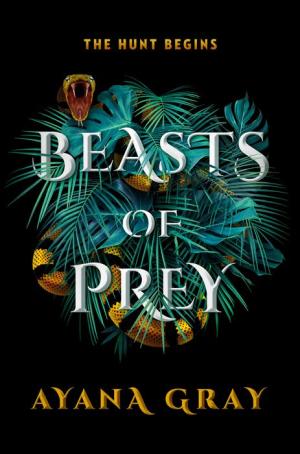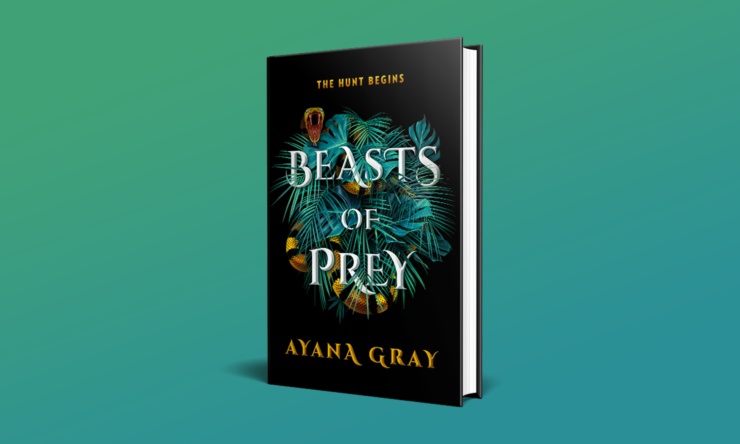In the Pan-African inspired fantasy land of Eshōza, a monster known as the Shetani hunts and kills anyone who strays into its jungle. For nearly a century, the citizens of the city of Lkossa have feared the beast, but now two teens from opposite ends of the social hierarchy are teaming up to take it down.
As an indentured servant to the Night Zoo, Koffi tends to and trains strange and dangerous creatures with her mother. The end of their contract is close enough to taste, but a tragic event pushes that deadline far into the future. Staring down a lifetime of being chained to the zoo, Koffi strikes a deal to pay off her and her loved ones’ debts in exchange for capturing the dreaded Shetani. Ekon, the son of one of the most powerful families in Lkossa, is on the verge of becoming a Son of the Six, elite warriors who protect the city and brutally enforce its rules. When his chance at a promotion is stripped away, he decides his best chance at gaining his position back is to do something spectacular: kill the Shetani.
With their goals temporarily overlapping, Koffi and Ekon set off into the jungle together. There they face exhilarating adventures, bloodthirsty creatures straight out of myths, a pair of scheming, manipulative gods, and one lost young woman who made a terrible choice as a child and is now burdened with the consequences. Only Ekon and Koffi can stop the Shentani from killing again and free the woman from her curse, but the secrets they keep from each other could destroy everything.
One of the things I love most about Beasts of Prey is how well Gray utilizes YA fantasy tropes. She dabbles with the Chosen One, enemies to lovers, the epic quest, the corrupt authority figure, among others. This is not a ding on tropes, mind you. I love ‘em. Tropes make the world go ‘round. Gray takes those wonderful tropes we’ve seen a million times and applies them to the narrative in provocative ways, both respecting the classic trope and also pushing it to the edge.
Buy the Book


Beasts of Prey
Through her characters, Gray examines how these tropes change when the protagonists aren’t privileged, idealized, or white. We explore why the Chosen Ones were chosen, who did the choosing, and the consequences of rejecting being chosen. The enemies to lovers trope gains a realness and depth with their associated characters; their relationship is not insta-love or a situation where they get together because there are no other available characters in the story. Ekon and Koffi’s jungle quest is beset with obstacles, but the ways they perceive, interact with, and engage in conflict with those obstacles twists the trope on its head.
It’s tempting to write Koffi off as impulsive and headstrong, but she’s so much more than that. Or, more accurately, there are deep, traumatic reasons for her recklessness and stubbornness. Most of her life has been spent in indenture to a callous zoo owner who treats her as poorly as he does his animals. It is vital no one—not her employer, not her friends, and especially not the Six—ever discovers her ability to do splendor, the old name for magic. Koffi doesn’t have the luxury of dreaming big or wishing on stars. Reality is hard enough without the constant reminder of what you cannot have. She has never been able to make her own choices, and her only dream is freedom. The connection to splendor and her fledgling relationship with Ekon are the only things in her life that are truly hers, and both could kill her as easily as they could help her. What lengths would you go when your one chance at freedom is snatched away from you at the last minute?
I did not know this going in, but Beasts of Prey has a neurodivergent main character. Ekon is an aspect of neurodivergent representation I don’t often see in young adult fiction, at least not done as well as it is here. It is unclear to me exactly what Ekon is dealing with, but he’s probably somewhere in the vicinity of obsessive-compulsion disorder and/or the autism spectrum. He has had enough experience with neurotypical people reacting negatively or derisively to his issues, so he masks his compulsions, repetitive behaviors, and counting. He frequently counts, taps his fingers together, and has numbers that “feel good.” When Koffi encounters his ND stuff, she accepts them without complaint, mockery, or hounding him with invasive questions. Gray shows how Ekon’s compulsions aren’t just weird things he does but are a part of who he is. He and Koffi move beyond basic accommodation and find ways to put his compulsions to use. His disability isn’t a plot device or a throwaway eccentricity but a fundamental part of who he is and how he moves through the story.
I saw a lot of myself in him. Like Ekon, I need numbers to feel balanced in my mind. I prefer even numbers because then things are balanced on each side, but I also like the number “3” because there is a point each on either side of the center point so it’s an odd number that’s also even; yes, I know it’s weird, but that’s just how my brain works, so there. However, I want to give a quick word of warning if your compulsions are easily activated. I expend an inordinate amount of energy masking during the day, in particular trying not to obsess over unbalanced numbers and reminding myself not to tic (I often flex muscles or touch things repeatedly until both sides of my body feel even). I had to skip over a lot of his counting and finger tapping scenes because once I started thinking about his numbers and tics it was impossible to not think about my numbers and tics, which sent me off on a new compulsion spiral. I hope this doesn’t dissuade readers with OCD or OCD-like tendencies from reading this book, but be aware of your boundaries going in.
A debut author’s first book in a series has a lot of work to do. It must establish the author as well as the story and characters. As readers, we take a leap of faith on an author we know little about, trusting them to take us on an engaging and exciting journey. Sometimes that faith is let down with a story the author wasn’t experienced enough as a writer yet to tell. Sometimes our faith is upheld but only because the book meets all the requirements for “it’s fine.” And sometimes we get a series opener like Beasts of Prey by debut Ayana Gray, an impressive piece of work that not only demonstrates great skill but is a pleasure to read.
Beasts of Prey is published by G.P. Putnam’s Sons Books for Young Readers.
Read an except here.
Alex Brown is an Ignyte award-winning critic who writes about speculative fiction, librarianship, and Black history. Find them on twitter (@QueenOfRats), instagram (@bookjockeyalex), and their blog (bookjockeyalex.com).










